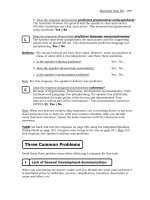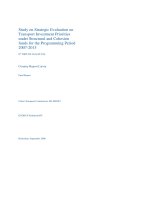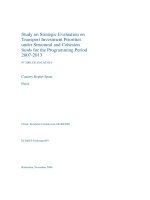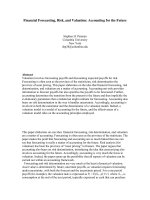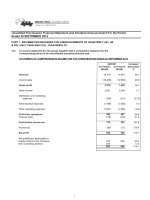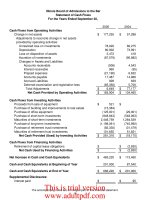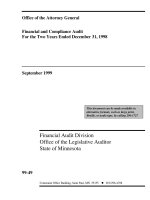ACCA PAPER F2 TAXATION PRATICE AND REVISION KIT FOR THE EXAM IN 2015 PART 5 BPP
Bạn đang xem bản rút gọn của tài liệu. Xem và tải ngay bản đầy đủ của tài liệu tại đây (3.91 MB, 289 trang )
FI33RK14 (POL & HO)_Layout 1 20/11/2013 15:28 Page 1
About BPP Learning Media
BPP Learning Media is dedicated to supporting aspiring business professionals with top quality learning material as they study for
demanding professional exams, often whilst working full time. BPP Learning Media’s commitment to student success is shown by
our record of quality, innovation and market leadership in paper-based and e-learning materials. BPP Learning Media’s study materials
are written by professionally-qualified specialists who know from personal experience the importance of top quality materials for
exam success.
FMA
MANAGEMENT ACCOUNTING
PAPER F2
MANAGEMENT ACCOUNTING
FMA MANAGEMENT ACCOUNTING
PAPER F2 MANAGEMENT ACCOUNTING
BPP Learning Media is the sole ACCA Platinum Approved Learning Partner - content.
FIA & ACCA
FIA &ACCA
FIA
FMA
MANAGEMENT ACCOUNTING
ACCA
PAPER F2
MANAGEMENT ACCOUNTING
This Practice & Revision Kit has been reviewed by the examiner to ensure that it provides full coverage of the syllabus and
study guide for FIA FMA Management Accounting and ACCA Paper F2 Management Accounting of the ACCA’s Foundations in
Accountancy qualifications.
When you have worked through it you will be ready to tackle the mock exams at the end of the Kit and compare your answers
with ours.
Targeted at FIA exams from February 2014, it contains:
n DO YOU KNOW? Checklists to test your knowledge of Management Accounting topics
n A bank of exam-standard MCQs with answers, covering the syllabus
n Two mock exams including the FMA/F2 pilot paper
For more details about this or any other BPP Learning Media products, please call our customer services team on
0845 0751 100 (within the UK) or +44 (0)20 8740 2211 (from overseas), email or visit our website
www.bpp.com/learningmedia
BPP House, Aldine Place, London W12 8AA
Tel: 0845 0751 100 (for orders within the UK)
Tel: +44 (0)20 8740 2211
Fax: +44 (0)20 8740 1184
www.bpp.com/learningmedia
FOR EXAMS
FROM
FEBRUARY 2014
NOVEMBER 2013
UK £15.00
PRACTICE &
REVISION KIT
At BPP Learning Media, we specialise in helping people pass professional exams. Your exam success is our business.
PRACTICE & REVISION KIT
FOR EXAMS FROM FEBRUARY 2014
FMA
PAPER F2
MANAGEMENT ACCOUNTING
Welcome to BPP Learning Media's Practice and Revision Kit for FMA. In this
FMA/F2 Practice and Revision Kit reviewed by the examiner:
We include Do you know? Checklists to test your knowledge and
understanding of topics
We provide you with two mock exams including the Specimen exam
We provide the ACCA examiner’s answers as well as our own to the
Specimen exam as an additional revision aid
BPP's i-Pass product also supports this paper and is a vital tool if you are taking the
computer based exam.
Note
FIA FMA and ACCA Paper F2 are examined under the same syllabus and study guide.
FOR EXAMS FROM FEBRUARY 2014 TO AUGUST 2015
P
R
A
C
T
I
C
E
&
R
E
V
I
S
I
O
N
K
I
T
FMA/F2 MANAGEMENT ACCOUNTING
First edition May 2011
Third edition November 2013
ISBN 9781 4453 7035 4
(Previous ISBN 9781 4453 9978 2)
e-ISBN 9781 4453 7070 5
British Library Cataloguing-in-Publication Data
A catalogue record for this book
is available from the British Library
Published by
BPP Learning Media Ltd
BPP House, Aldine Place
London W12 8AA
www.bpp.com/learningmedia
Printed in the United Kingdom by Polestar Wheatons
Hennock Road
Marsh Barton
Exeter
EX2 8RP
Your learning materials, published by BPP Learning
Media Ltd, are printed on paper obtained from traceable
sustainable sources.
All our rights reserved. No part of this publication may
be reproduced, stored in a retrieval system or
transmitted, in any form or by any means, electronic,
mechanical, photocopying, recording or otherwise,
without the prior written permission of BPP Learning
Media.
We are grateful to the Association of Chartered Certified
Accountants for permission to reproduce past
examination questions. The suggested solutions in the
exam answer bank have been prepared by BPP Learning
Media Ltd, except where otherwise stated.
©
BPP Learning Media Ltd
2013
ii
A note about copyright
Dear Customer
What does the little © mean and why does it matter?
Your market-leading BPP books, course materials
and e-learning materials do not write and update
themselves. People write them: on their own behalf
or as employees of an organisation that invests in
this activity. Copyright law protects their livelihoods.
It does so by creating rights over the use of the
content.
Breach of copyright is a form of theft – as well being
a criminal offence in some jurisdictions, it is
potentially a serious breach of professional ethics.
With current technology, things might seem a bit
hazy but, basically, without the express permission
of BPP Learning Media:
Photocopying our materials is a breach of
copyright
Scanning, ripcasting or conversion of our digital
materials into different file formats, uploading
them to facebook or emailing them to your
friends is a breach of copyright
You can, of course, sell your books, in the form in
which you have bought them – once you have
finished with them. (Is this fair to your fellow
students? We update for a reason.) Please note the
e-products are sold on a single user licence basis: we
do not supply ‘unlock’ codes to people who have
bought them second hand.
And what about outside the UK? BPP Learning
Media strives to make our materials available at
prices students can afford by local printing
arrangements, pricing policies and partnerships
which are clearly listed on our website. A tiny
minority ignore this and indulge in criminal activity
by illegally photocopying our material or supporting
organisations that do. If they act illegally and
unethically in one area, can you really trust them?
CONTENTS
Contents
Page
Finding questions
Question index .............................................................................................................................. v
Helping you with your revision ....................................................................................................... vii
Using your BPP Practice and Revision Kit...................................................................................... viii
Passing the FMA/F2 exam ............................................................................................................. ix
Approach to examining the syllabus ................................................................................................ ix
The Computer Based Examination ................................................................................................... x
Tackling Multiple Choice Questions................................................................................................. xi
Using your BPP products.............................................................................................................. xii
Questions and answers
Questions .................................................................................................................................... 3
Answers .................................................................................................................................. 137
Formula sheet and tables ............................................................................................................. 211
Exam practice
Mock exam 1 (Specimen exam)
Questions......................................................................................................................... 219
Answers........................................................................................................................... 233
ACCA examiner’s answers.................................................................................................. 241
Mock exam 2
Questions......................................................................................................................... 249
Answers........................................................................................................................... 261
Review form
iii
FMA/F2 MANAGEMENT ACCOUNTING
iv
QUESTION INDEX
Question index
Time
allocation
Marks
Page
Mins
Questions
Answer
Part A: The nature, source and purpose of
management information
1 Accounting for management
20
24
5
137
2 Sources of data
10
12
9
137
3 Cost classification
24
29
13
138
4 Cost behaviour
36
43
15
139
8
10
19
141
6 Accounting for materials
44
53
23
141
7 Accounting for labour
24
29
28
145
8 Accounting for overheads
48
58
35
147
9 Absorption and marginal costing
36
43
41
151
10 Job, batch and service costing
32
38
47
154
11 Process costing
30
36
50
156
12 Process costing, joint products and by-products
14
17
53
159
13 Alternative costing principles
12
14
55
160
14 Forecasting
64
77
59
161
15 Budgeting
20
24
64
165
16 The budgetary process
48
58
66
167
17 Making budgets work
12
14
72
170
18 Capital expenditure budgeting
8
10
75
171
19 Methods of project appraisal
48
58
75
171
5 Presenting information
Part B: Cost accounting methods and systems
Part C: Budgeting
v
FMA/F2 MANAGEMENT ACCOUNTING
Time
allocation
Marks
Page
Mins
Questions
Answer
Part D: Standard costing
20 Standard costing
14
17
83
175
21 Basic variance analysis
38
46
84
176
22 Further variance analysis
44
53
89
179
23 Performance measurement
26
31
97
183
24 Applications of performance measurement
30
36
99
183
25 Mixed Bank 1
40
48
103
185
26 Mixed Bank 2
40
48
109
188
27 Mixed Bank 3
40
48
113
190
28 Mixed Bank 4
30
36
118
192
29 Mixed Bank 5
20
24
121
195
30 Budgeting
50
60
125
199
31 Standard costing
50
60
128
202
32 Performance measurement
50
60
131
205
Mock Exam 1 (Specimen exam)
100
120
219
233
Mock Exam 2
100
120
249
261
Part E: Performance measurement
Mixed banks
Multi-task questions
Mock exams
vi
USING YOUR PRACTICE AND REVISION KIT
Helping you with your revision
BPP Learning Media – Approved Learning Partner – content
As ACCA’s Approved Learning Partner – content, BPP Learning Media gives you the opportunity to use
examiner-reviewed revision materials for exams from February 2014 to August 2015. By incorporating
the examiner’s comments and suggestions regarding syllabus coverage, the BPP Learning Media
Practice and Revision Kit provides excellent, ACCA-approved support for your revision.
Selecting questions
We provide signposts to help you plan your revision.
A full question index listing questions that cover each part of the syllabus, so that you can locate
the questions that provide practice on key topics, and see the different ways in which they might
be tested
Attempting mock exams
There are two mock exams that provide practice at coping with the pressures of the exam day. We
strongly recommend that you attempt them under exam conditions. Mock exam 1 is the Specimen
exam. Mock exam 2 reflects the question styles and syllabus coverage of the exam.
vii
FMA/F2 MANAGEMENT ACCOUNTING
Using your BPP Practice and Revision Kit
Aim of this Practice and Revision Kit
To provide the practice to help you succeed in both the paper based and computer based examinations
for Paper FMA/F2 Management Accounting.
To pass the examination you need a thorough understanding in all areas covered by the syllabus and
teaching guide.
Recommended approach
viii
Make sure you are able to answer questions on everything specified by the syllabus and teaching
guide. You cannot make any assumptions about what questions may come up on your paper. The
examiners aim to discourage 'question spotting'.
Learning is an active process. Use the DO YOU KNOW? Checklists to test your knowledge and
understanding of the topics covered in FMA/F2 Management Accounting by filling in the blank
spaces. Then check your answers against the DID YOU KNOW? Checklists. Do not attempt any
questions if you are unable to fill in any of the blanks - go back to your BPP Interactive Text and
revise first.
When you are revising a topic, think about the mistakes that you know that you should avoid by
writing down POSSIBLE PITFALLS at the end of each DO YOU KNOW? Checklist.
Once you have completed the checklists successfully, you should attempt the questions on that
topic. Each question is worth 2 marks and carries with it a time allocation of 2.4 minutes.
Once you have completed all of the questions in the body of this Practice & Revision Kit, you
should attempt the MOCK EXAMS under examination conditions. Check your answers against our
answers to find out how well you did.
PASSING THE FMA/F2 EXAM
Passing the FMA/F2 exam
To access FIA and ACCA syllabuses, visit the ACCA website.
The exam
You can take this exam as a paper-based exam or by a computer-based exam (CBE). All questions in
the exam are compulsory. This means you cannot avoid any topic, but also means that you do not need
to waste time in the exam deciding which questions to attempt. There are 35 MCQs and 3 multi-task
questions in the paper based exam and a mixture of 35 MCQs and other types of objective test question
(OTQ) (for example, number entry, multiple response and multiple response matching) and 3 multi-task
questions in the CBE. This means that the examiner is able to test most of the syllabus at each sitting,
and that is what they will aim to do. So you need to have revised right across the syllabus for this
exam.
Revision
This kit has been reviewed by the FMA/F2 examiner and contains the Specimen exam, so if you just
worked through it to the end you would be very well prepared for the exam. It is important to tackle
questions under exam conditions. Allow yourself just the number of minutes shown next to the
questions in the index and don’t look at the answers until you have finished. Then correct your answer
and go back to the Interactive Text for any topic you are really having trouble with. Try the same
question again a week later – you will be surprised how much better you are getting. Doing the
questions like this will really show you what you know, and will make the exam experience less
worrying.
Doing the exam
If you have honestly done your revision you can pass this exam. There are certain points which you
must bear in mind:
Read the question properly.
Don’t spend more than the allotted time on each question. If you are having trouble with a
question leave it and carry on. You can come back to it at the end.
Approach to examining the syllabus
FMA/F2 is a two-hour paper. It can be taken as a paper based or a computer based examination.
The exam is structured as follows:
35 compulsory objective test questions of 2 marks each
3 compulsory multi-task questions of 10 marks each
No of marks
70
30
100
ix
FMA/F2 MANAGEMENT ACCOUNTING
The Computer Based Examination
Computer based examinations (CBEs) are available for the first seven FIA papers (not papers FAU, FTM
or FFM), and the first three ACCA exams (F1, F2 and F3), in addition to the conventional paper based
examination.
Computer based examinations must be taken at an ACCA CBE Licensed Centre.
How do CBEs work?
Questions are displayed on a monitor
Candidates enter their answer directly onto the computer
Candidates have two hours to complete the examination
When the candidate has completed their examination, the final percentage score is calculated
and displayed on screen
Candidates are provided with a Provisional Result Notification showing their results before leaving
the examination room
The CBE Licensed Centre uploads the results to the ACCA (as proof of the candidate's
performance) within 72 hours
Candidates can check their exam status on the ACCA website by logging into myACCA.
Benefits
Flexibility as a CBE can be sat at any time.
Resits can also be taken at any time and there is no restriction on the number of times a
candidate can sit a CBE.
Instant feedback as the computer displays the results at the end of the CBE.
Results are notified to ACCA within 72 hours.
CBE question types
Multiple choice – choose one answer from four options
Number entry – key in a numerical response to a question
Multiple response – select more than one response by clicking the appropriate tick boxes
Multiple response matching – select a response to a number of related part questions by choosing
one option from a number of drop down menus
For more information on computer-based exams, visit the ACCA website.
/>
x
THE COMPUTER BASED EXAMINATION
Tackling Multiple Choice Questions
MCQs are part of all FIA exams and the first three ACCA exams (F1, F2 and F3). MCQs may feature in
the CBE, along with other types of question, while the paper based exam is made up entirely of MCQs.
The MCQs in your exam contain four possible answers. You have to choose the option that best
answers the question. The three incorrect options are called distracters. There is a skill in answering
MCQs quickly and correctly. By practising MCQs you can develop this skill, giving you a better chance of
passing the exam.
You may wish to follow the approach outlined below, or you may prefer to adapt it.
Step 1
Skim read all the MCQs and identify what appear to be the easier questions.
Step 2
Attempt each question – starting with the easier questions identified in Step 1. Read
the question thoroughly. You may prefer to work out the answer before looking at the
options, or you may prefer to look at the options at the beginning. Adopt the method
that works best for you.
Step 3
Read the four options and see if one matches your own answer. Be careful with
numerical questions as the distracters are designed to match answers that incorporate
common errors. Check that your calculation is correct. Have you followed the
requirement exactly? Have you included every stage of the calculation?
Step 4
You may find that none of the options matches your answer.
Re-read the question to ensure that you understand it and are answering the
requirement
Eliminate any obviously wrong answers
Consider which of the remaining answers is the most likely to be correct and
select the option
Step 5
If you are still unsure make a note and continue to the next question
Step 6
Revisit unanswered questions. When you come back to a question after a break you
often find you are able to answer it correctly straight away. If you are still unsure have a
guess. You are not penalised for incorrect answers, so never leave a question
unanswered!
After extensive practice and revision of MCQs, you may find that you recognise a question when you sit
the exam. Be aware that the detail and/or requirement may be different. If the question seems familiar
read the requirement and options carefully – do not assume that it is identical.
xi
FMA/F2 MANAGEMENT ACCOUNTING
Using your BPP products
This Kit gives you the question practice and guidance you need in the exam. Our other products can also help
you pass:
Passcards provide you with clear topic summaries and exam tips
i-Pass CDs are a vital revision tool for anyone taking FIA/ACCA CBEs and offer tests of
knowledge against the clock in an environment similar to that encountered in a computer
based exam
You can purchase these products by visiting www.bpp.com/learningmedia
xii
Questions
1
FMA/F2 MANAGEMENT ACCOUNTING
2
QUESTIONS
Do you know? – Accounting for management
Check that you can fill in the blanks in the statements below before you attempt any questions. If in doubt,
you should go back to your BPP Interactive Text and revise first.
Good information should be ……….., ……….., ……….., and ……. It should inspire confidence, it
should be appropriately communicated, its volume should be manageable, it should be timely and its
cost should be less than the benefits it provides.
Information for management is likely to be used for
–
–
–
........................................................
........................................................
........................................................
The main objective of profit making organisations is to ………… ………... A secondary objective of
profit making organisations might be to increase ………… of its goods/services.
The main objective of non-profit making organisations is usually to ……… …….. and services. A
secondary objective of non-profit making organisations might be to minimise the ……. involved in
providing the goods/services.
Long-term ……… planning, also known as corporate planning, involves selecting appropriate …………
so as to prepare a long-term plan to attain the objectives.
Anthony divides management activities into ……….. planning, ………… control and …………. control.
Tactical (or management) control: 'the process by which managers assure that ……….. are obtained
and used effectively and efficiently in the accomplishment of the organisation's objectives'.
Operational control: 'the process of assuring that specific ……… are carried out ………. and ………….
…………… accounts are prepared for individuals external to an organisation: shareholders, customers,
suppliers, tax authorities, employees.
……………. accounts are prepared for internal managers of an organisation.
There is no legal requirement to prepare ………….. accounts.
……………. accounts are both an historical record and a future planning tool.
……………. accounts concentrate on the business as a whole, aggregating revenues and costs from
different operations, and are an end in themselves.
Cost accounting information is, in general, unsuitable for ……… ………..
Possible pitfalls
Write down the mistakes you know you should avoid.
3
FMA/F2 MANAGEMENT ACCOUNTING
Did you know? – Accounting for management
Could you fill in the blanks? The answers are in bold. Use this page for revision purposes as you approach
the exam.
Good information should be relevant, complete, accurate, and clear. It should inspire confidence, it
should be appropriately communicated, its volume should be manageable, it should be timely and its
cost should be less than the benefits it provides.
Information for management is likely to be used for
–
–
–
Planning
Control
Decision-making
The main objective of profit making organisations is to maximise profits. A secondary objective of profit
making organisations might be to increase output of its goods/services.
The main objective of non-profit making organisations is usually to provide goods and services. A
secondary objective of non-profit making organisations might be to minimise the costs involved in
providing the goods/services.
Long-term strategic planning, also known as corporate planning, involves selecting appropriate
strategies so as to prepare a long-term plan to attain the objectives.
Anthony divides management activities into strategic planning, management control and operational
control.
Tactical (or management) control: 'the process by which managers assure that resources are obtained
and used effectively and efficiently in the accomplishment of the organisation's objectives'.
Operational control: 'the process of assuring that specific tasks are carried out effectively and efficiently'.
Financial accounts are prepared for individuals external to an organisation: shareholders, customers,
suppliers, tax authorities, employees.
Management accounts are prepared for internal managers of an organisation.
There is no legal requirement to prepare management accounts.
Management accounts are both an historical record and a future planning tool.
Financial accounts concentrate on the business as a whole, aggregating revenues and costs from
different operations, and are an end in themselves.
Cost accounting information is, in general, unsuitable for decision making.
Possible pitfalls
–
4
Forgetting the differences between financial and management accounting
QUESTIONS
1
Accounting for management
1.1
Which of the following statements about qualities of good information is false?
A
B
C
D
1.2
1.4
1.5
It should be relevant for its purposes
It should be communicated to the right person
It should be completely accurate
It should be timely
(2 marks)
The sales manager has prepared a manpower plan to ensure that sales quotas for the forthcoming year
are achieved. This is an example of what type of planning?
A
B
C
D
1.3
24 mins
Strategic planning
Tactical planning
Operational planning
Corporate planning
(2 marks)
Which of the following statements about management accounting information is/are true?
1
2
3
They must be stated in purely monetary terms
Limited companies must, by law, prepare management accounts
They serve as a future planning tool and are not used as an historical record
A
B
C
D
1, 2 and 3
1 and 2
2 only
None of the statements is true
(2 marks)
Which of the following statements is/are correct?
1
A management control system is a term used to describe the hardware and software used to drive
a database system which produces information outputs that are easily assimilated by
management.
2
An objective is a course of action that an organisation might pursue in order to achieve its
strategy.
3
Information is data that has been processed into a form meaningful to the recipient.
A
B
C
D
1, 2 and 3
1 and 3
2 and 3
3 only
(2 marks)
Good information should have certain qualities. Which of the following are qualities of good information?
1
2
3
4
Complete
Extensive
Relevant
Accurate
A
B
C
D
1, 2 and 3
1, 3 and 4
2 and 4
All of them
(2 marks)
5
FMA/F2 MANAGEMENT ACCOUNTING
1.6
Monthly variance reports are an example of which one of the following types of management
information?
A
B
C
D
1.7
1.8
(2 marks)
Which of the following statements is/are correct?
1
2
Information for decision-making should incorporate uncertainty in some way
The data used to prepare financial accounts and management accounts are the same
A
B
C
D
1 is true and 2 is false
2 is true and 1 is false
Both are true
Both are false
(2 marks)
Which of the following processes occurs at the business planning stage?
A
B
C
D
1.9
Tactical
Strategic
Non-financial
Operational
Obtaining data about actual results
Taking corrective action
Comparing actual performance with budget
Establishing objectives
(2 marks)
Which of the following statements is correct?
A
B
C
D
Management accounting systems provide information for use in fulfilling legal requirements
Management accounting systems provide information for the use of decision-makers within an
organisation
Management accounting systems provide information for use by shareholders
Management accounting systems provide information for use by tax authorities
(2 marks)
1.10 Which of the following would be data rather than information?
A
B
C
D
Sales increase/decrease per product in last quarter
Total sales value per product
Sales made per salesman as a percentage of total sales
Sales staff commission as a percentage of total sales
(2 marks)
(Total = 20 marks)
6
QUESTIONS
Do you know? – Sources of data
Check that you can fill in the blanks in the statements below before you attempt any questions. If in doubt,
you should go back to your BPP Interactive Text and revise first
Data may be ……….. (collected specifically for the purpose of a survey) or ………. (collected for some
other purpose)
You will remember that primary data are data collected especially for a specific purpose. The advantage
of such data is that the investigator knows where the data …….. ……… and is aware of any
inadequacies or limitations in the data. Its disadvantage is that it can be very ………… to collect
primary data
Secondary data sources may be satisfactory in certain situations, or they may be the only convenient
means of obtaining an item of data. It is essential that there is good reason to believe that the secondary
data used is ……… and ………..
The main sources of secondary data are:
–
–
–
–
........................................................
........................................................
........................................................
........................................................
–
–
–
–
………………………………….
…………………………………..
…………………………………..
…………………………………..
In such situations where it is not possible to survey the whole population, a ……… is selected. The
results obtained from this are used to estimate the results of the whole population. In situations where
the whole population is examined, the survey is called a ……….. This situation is quite rare, which
means that the investigator must choose a sample.
A …………. sampling method is a sampling method in which there is a known chance of each member
of the population appearing in the sample.
A ……… ……… sample is a sample selected in such a way that every item in the population has an
equal chance of being included.
If random sampling is used then it is necessary to construct a ……… …….. Once a numbered list of all
items in the population has been made, it is easy to select a ……… sample, simply by generating a list
of random numbers
………… random sampling is a method of sampling which involves dividing the population into strata or
categories. Random samples are then taken from each stratum or category. The main disadvantage of
stratification is that it requires ………. ……….. of each item in the population; sampling frames do not
always contain such information.
Systematic sampling is a sampling method which works by selecting every nth item after a random start.
The advantages of systematic sampling are ......................................... and
……………………………………..
Multistage sampling is a probability sampling method which involves dividing the ………. into a number
of …….-……….. and then selecting a small sample of these at random. Each …..-………. is then
divided further, and then a small sample is again selected at random. This process is repeated as many
times as is necessary.
………… sampling is a non-random sampling method that involves selecting one definable subsection
of the population as the sample, that subsection taken to be representative of the population in
question.
In quota sampling, ………… is forfeited in the interests of cheapness and administrative simplicity.
Investigators are told to interview all the people they meet up to a certain quota.
Possible pitfalls
Write down the mistakes you know you should avoid.
7
FMA/F2 MANAGEMENT ACCOUNTING
Did you know? – Sources of data
Could you fill in the blanks? The answers are in bold. Use this page for revision purposes as you approach
the exam.
Data may be primary (collected specifically for the purpose of a survey) or secondary (collected for some
other purpose).
You will remember that primary data are data collected especially for a specific purpose. The advantage
of such data is that the investigator knows where the data came from and is aware of any inadequacies
or limitations in the data. Its disadvantage is that it can be very expensive to collect primary data.
Secondary data sources may be satisfactory in certain situations, or they may be the only convenient
means of obtaining an item of data. It is essential that there is good reason to believe that the secondary
data used is accurate and reliable
The main sources of secondary data are: Governments; banks; newspapers; trade journals; information
bureaux; consultancies; libraries and information services.
In such situations where it is not possible to survey the whole population, a sample is selected. The
results obtained from this are used to estimate the results of the whole population. In situations where
the whole population is examined, the survey is called a census. This situation is quite rare, which
means that the investigator must choose a sample.
A probability sampling method is a sampling method in which there is a known chance of each member
of the population appearing in the sample.
A simple random sample is a sample selected in such a way that every item in the population has an
equal chance of being included.
If random sampling is used then it is necessary to construct a sampling frame. Once a numbered list of
all items in the population has been made, it is easy to select a random sample, simply by generating a
list of random numbers.
Stratified random sampling is a method of sampling which involves dividing the population into strata or
categories. Random samples are then taken from each stratum or category. The main disadvantage of
stratification is that it requires prior knowledge of each item in the population; sampling frames do not
always contain such information.
Systematic sampling is a sampling method which works by selecting every nth item after a random start.
The advantages of systematic sampling are that it is easy to use and it is cheap.
Multistage sampling is a probability sampling method which involves dividing the population into a
number of sub-populations and then selecting a small sample of these at random. Each sub-population
is then divided further, and then a small sample is again selected at random. This process is repeated as
many times as is necessary.
Cluster sampling is a non-random sampling method that involves selecting one definable subsection of
the population as the sample, that subsection taken to be representative of the population in question.
In quota sampling, randomness is forfeited in the interests of cheapness and administrative simplicity.
Investigators are told to interview all the people they meet up to a certain quota.
Possible pitfalls
–
–
8
Mixing up the different types of sampling
Not knowing the advantages and disadvantages of the sampling methods
QUESTIONS
2
Sources of data
2.1
2.2
12 mins
Which of the following is/are primary sources of data?
(i)
Historical records of transport costs to be used to prepare forecasts for budgetary planning
(ii)
The Annual Abstract of Statistics, published by the Office for National Statistics in the United
Kingdom
(iii)
Data collected by a bank in a telephone survey to monitor the effectiveness of the bank's
customer services
A
B
C
D
(i) and (ii)
(i) and (iii)
(i) only
(iii) only
(2 marks)
The following statements relate to different types of data
(i)
(ii)
(iii)
(iv)
Secondary data are data collected especially for a specific purpose
Discrete data can take on any value
Qualitative data are data that cannot be measured
Population data are data arising as a result of investigating a group of people or objects
Which of the statements are true?
A
B
C
D
2.3
2.4
(i) and (ii) only
(ii) and (iii) only
(ii) and (iv) only
(iii) and (iv) only
(2 marks)
Which of the following statements are false?
(i)
If a sample is selected using random sampling, it will be free from bias.
(ii)
A sampling frame is a numbered list of all items in a sample.
(iii)
In cluster sampling there is very little potential for bias.
(iv)
In quota sampling, investigators are told to interview all the people they meet up to a certain
quota.
A
B
C
D
(i), (ii), (iii) and (iv)
(i), (ii) and (iii)
(ii) and (iii)
(ii) only
(2 marks)
Government statistics can be a useful source of data and information.
Which one of the following types of data is most likely to be obtained from government statistics?
A
B
C
D
2.5
Foreign exchange rates
Population data
Details of industry costs
Interest rates
(2 marks)
Which of the following explains the essence of quota sampling?
A
B
C
D
Each element of the population has an equal chance of being chosen
Every nth member of the population is selected
Every element of one definable sub-section of the population is selected
None of the above
(2 marks)
(Total = 10 marks)
9
FMA/F2 MANAGEMENT ACCOUNTING
10
QUESTIONS
Do you know? – Cost classification and cost behaviour
Check that you can fill in the blanks in the statements below before you attempt any questions. If in doubt,
you should go back to your BPP Interactive Text and revise first.
A ……….. cost is a cost that can be traced in full to the product, service or department that is being
costed. An ……….. cost is a cost that is incurred in the course of making a product, providing a service
or running a department but which cannot be traced directly and in full to the product, service or
department.
In classification by function, costs are classified as follows
–
........................................................ These are associated with the factory.
–
........................................................ These are costs associated with general office
departments.
–
........................................................ These are costs associated with sales, marketing,
warehousing and transport departments.
A ………… cost is a cost which is incurred for a particular period of time and which, within certain
activity levels, is unaffected by changes in the level of activity. A ………... cost is a cost which tends to
vary with the level of activity. Many items of expenditure are part ………… and part ………… and are
called ………… costs.
The distinction between production and non-production costs is the basis of valuing ………
A ……….. centre is a department or organisational function whose performance is the direct
responsibility of a specific manager.
……….. centres are similar to cost centres but are accountable for costs and revenues.
An ……….. centre is a profit centre with additional responsibilities for capital investment and possibly
for financing, and whose performance is measured by its return on investment.
The basic principle of cost behaviour is that as the level of activity rises, costs will usually ….…...
The effect of increasing activity levels on unit costs is as follows. (Tick as appropriate)
Rises
Falls
Remains
constant
Variable cost per unit
Fixed cost per unit
Total cost per unit
The fixed and variable elements of semi-variable costs can be determined by the .........................
method.
Possible pitfalls
Write down the mistakes you know you should avoid.
11
FMA/F2 MANAGEMENT ACCOUNTING
Did you know? – Cost classification and cost behaviour
Could you fill in the blanks? The answers are in bold. Use this page for revision purposes as you approach
the exam.
A direct cost is a cost that can be traced in full to the product, service or department that is being
costed. An indirect cost is a cost that is incurred in the course of making a product, providing a service
or running a department but which cannot be traced directly and in full to the product, service or
department.
In classification by function, costs are classified as follows
–
Production or manufacturing costs. These are associated with the factory
–
Administration costs. These are costs associated with general office departments
–
Marketing or selling and distribution costs. These are costs associated with sales, marketing,
warehousing and transport departments
A fixed cost is a cost which is incurred for a particular period of time and which, within certain activity
levels, is unaffected by changes in the level of activity. A variable cost is a cost which tends to vary with
the level of activity. Many items of expenditure are part fixed and part variable and are called semivariable costs.
The distinction between production and non-production costs is the basis of valuing inventory
A responsibility centre is a department or organisational function whose performance is the direct
responsibility of a specific manager.
Profit centres are similar to cost centres but are accountable for costs and revenues.
An investment centre is a profit centre with additional responsibilities for capital investment and
possibly for financing, and whose performance is measured by its return on investment.
The basic principle of cost behaviour is that as the level of activity rises, costs will usually rise.
The effect of changing activity levels on unit costs is as follows. (Tick as appropriate)
Rises
Falls
Variable cost per unit
Fixed cost per unit
Total cost per unit
The fixed and variable elements of semi-variable costs can be determined by the high-low method.
Possible pitfalls
–
–
12
Remains
constant
Getting confused between fixed and variable costs – particularly if they are expressed per unit
Not grasping the difference between direct and indirect costs
